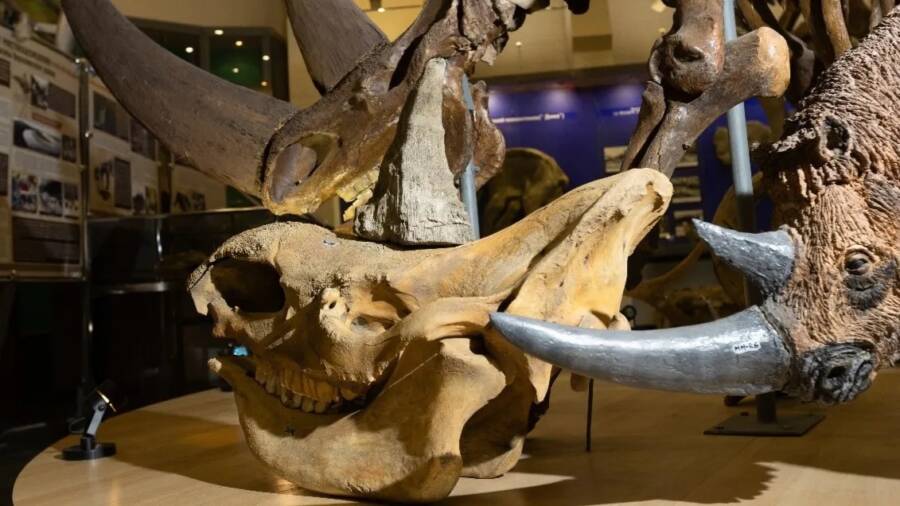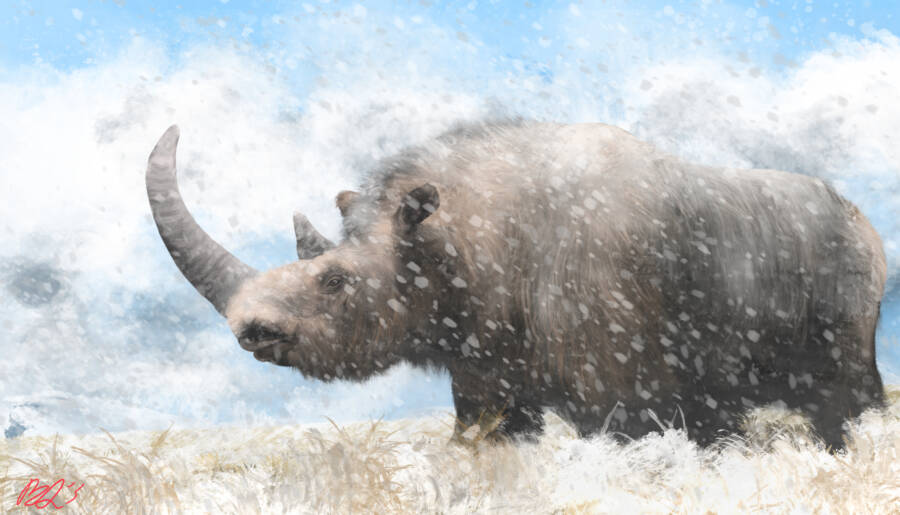This is just the fifth woolly rhino ever discovered with its soft tissues still preserved.

Michil Yakovlev/NEFUThe newly discovered horn placed atop a different woolly rhino skull at Siberia’s Mammoth Museum.
Gold miners in Russia were recently excavating a site for a new quarry when they unearthed a mummified woolly rhino carcass. However, the most surprising part of the discovery was that its horn and soft tissues were still intact.
Officials from North-Eastern Federal University (NEFU) now plan to excavate the rest of the rhino in the coming months — and they hope they can extract DNA from the preserved tissue.
The Discovery Of The Woolly Rhino Mummy
The discovery of the woolly rhino carcass was announced in a press release from NEFU on Aug. 5, 2024. The horn has since been transported to the NEFU Mammoth Museum in Yakutsk.
“This is a truly unique find that will allow us to study the history of the region, its ancient fauna, climate, and geological conditions in more depth,” said NEFU rector Anatoly Nikolaev. “We thank our partners for the transfer of this valuable find and their contribution to science. The donated fossil rhinoceros carcass is not just a valuable exhibit for the Mammoth Museum, but also an incredible resource for scientific research.”

Michil Yakovlev/NEFUThe horn was a rear frontal one from a mature woolly rhinoceros.
In the statement, senior researcher and head of the laboratory of the NEFU Mammoth Museum, Maxim Cheprasov, emphasized the high value of this find. Until now, only five woolly rhinoceroses with preserved soft tissues have ever been discovered. Cheprasov is confident that this new carcass will offer valuable insight into the lives of these prehistoric beasts.
“We have just returned from the place where the woolly rhinoceros was found, where we were given its horn,” Cheprasov said. “The fragmented carcass was preserved, and by prior agreement with partners, its extraction is scheduled for the fall. The donation of the woolly rhinoceros horn to NEFU is a significant event. Until today, there was no such rare find in the collection of the Mammoth Museum.”
The discovery was possible due to the unique Siberian permafrost, which created the ideal conditions to mummify and preserve the remains for more than 10,000 years. Cheprasov noted that it seems the horn belonged to a “mature individual,” though it’s too soon to say whether the woolly rhino was male or female.
“The exact biological age and sex of the animal will be determined after a comprehensive study of the carcass itself. Then we will be able to obtain data on anatomical and morphological features, geological age, nutrition, genetic links with previously studied finds, etc.,” Cheprasov said.
What Were Woolly Rhinoceroses?
Although woolly mammoths are fairly well known even in the modern world, their fellow woolly contemporaries are slightly more obscure.

Benjamin Langlois/Wikimedia CommonsAn artist’s rendition of a woolly rhinoceros.
The woolly rhinoceros (Coelodonta antiquitatis) was a large, prehistoric mammal that roamed the cold, arid plains of Europe and northern Asia until it went extinct about 10,000 years ago. Woolly rhinos were well-adapted to the harsh environment, sporting a thick, woolly coat that protected them from frigid temperatures. They stood around 6.5 feet tall at the shoulder and could weigh up to 6,000 pounds, rivaling today’s largest rhinos in size.
One of the most distinctive features of the woolly rhinoceros was its two large horns made of keratin, with the front horn sometimes reaching over three feet in length. These horns were likely used for defense, foraging, and possibly even in mating displays. Their bodies were robust, with short legs and large back humps formed by muscle and fat deposits, which aided in survival during food-scarce winters.
Now, researchers hope this newly discovered carcass can offer even more insight into the lives of these prehistoric creatures.
“I would like to note that the transfer of the find to the university is a vivid example of how cooperation between business and science can benefit the entire region,” Nikolaev said.
After reading about the discovery of this mummified woolly rhino, learn about 11 of the prehistoric world’s most fascinating animals. Then, read about life in Oymyakon, the Siberian city that’s the coldest inhabited place in the world.





